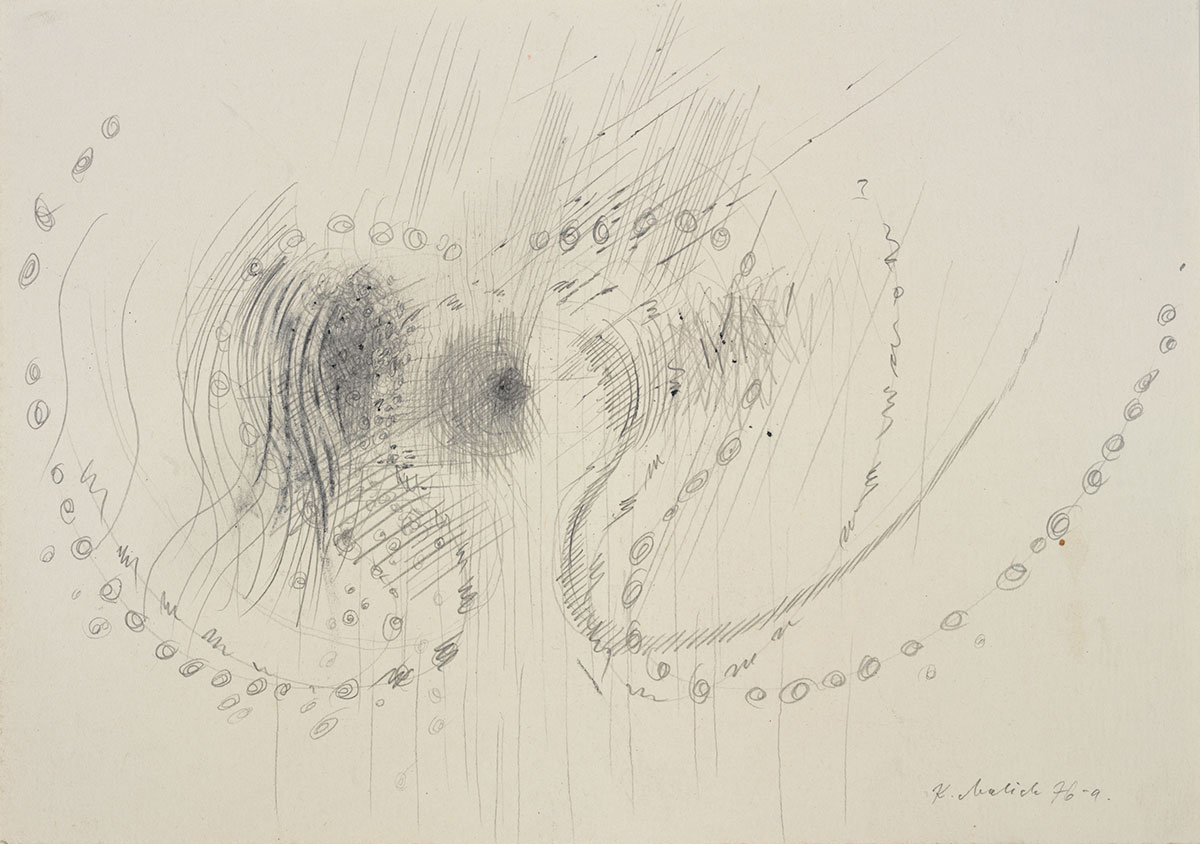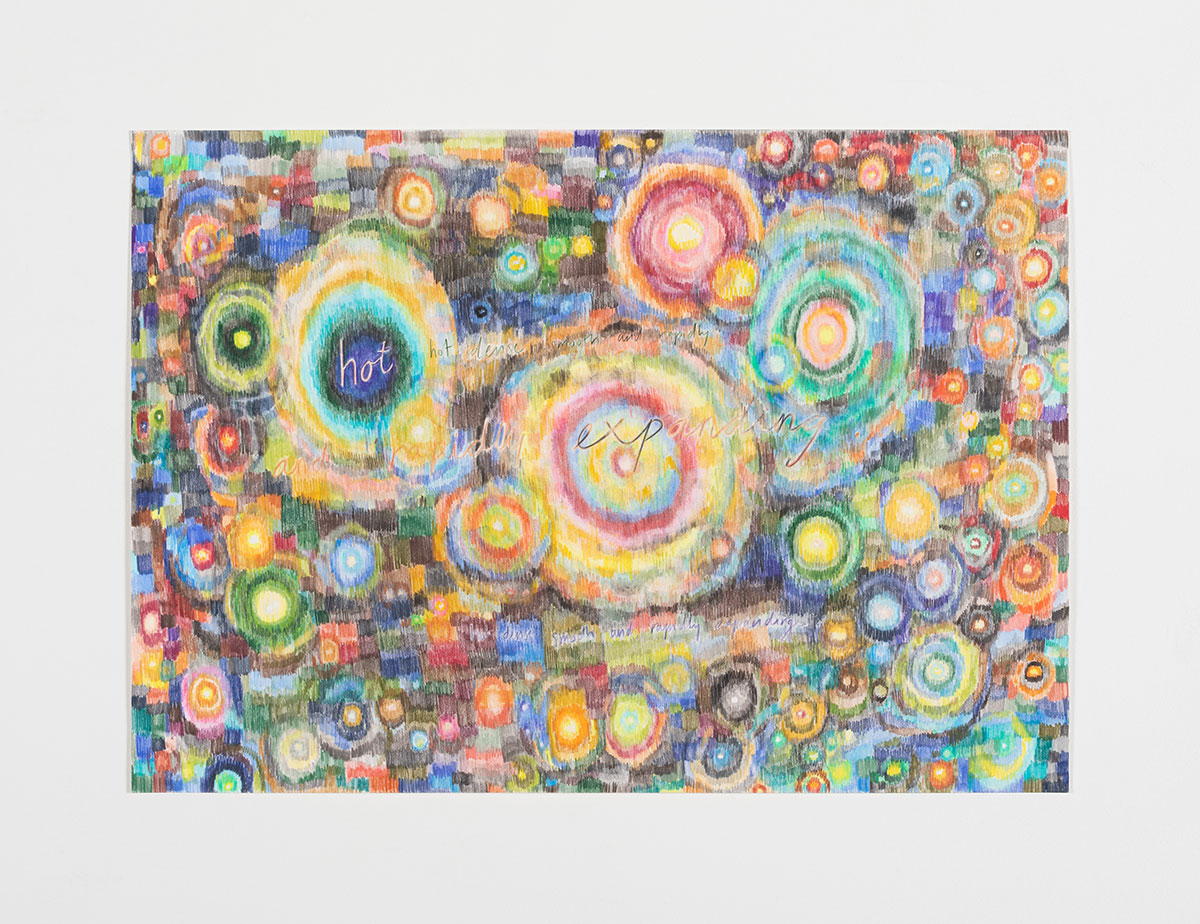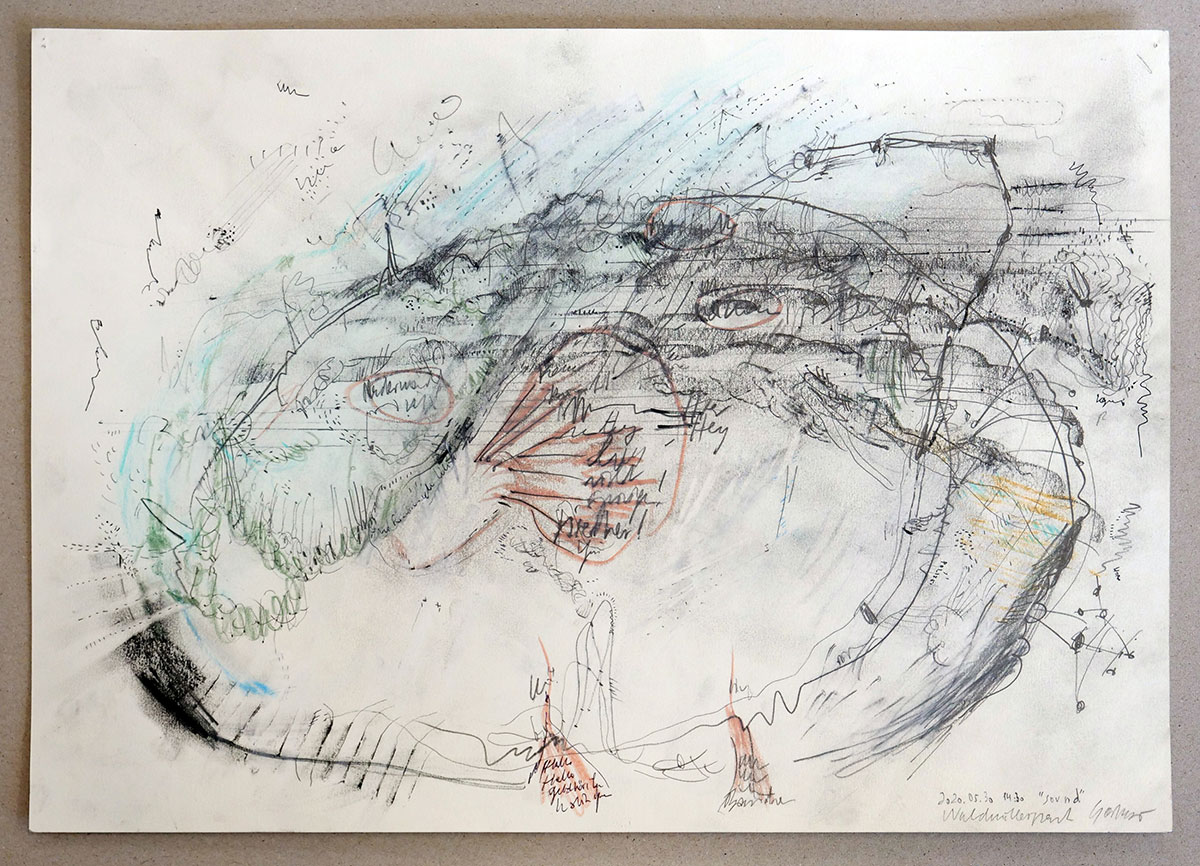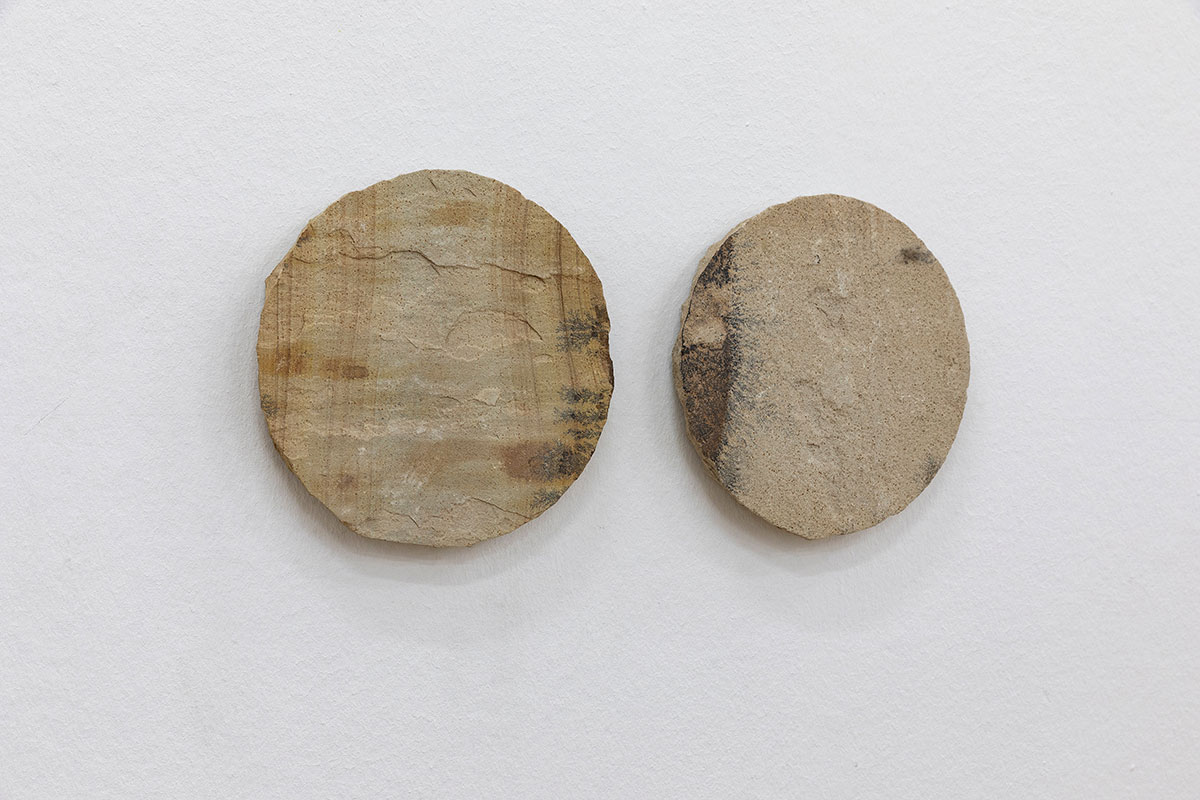ART-PRESENTATION:Line as Thought, Lines as Universe
 The exhibition “Line as Thought, Lines as Universe” examines contemporary drawing practices in comparison with some pioneers of abstract drawing from the past several decades. The exhibition concept was first inspired by drawings made by the late Romanian artist, Alina Popa. During an illness and leading up to her death in 2019, Alina Popa produced an incredible body of drawings that profoundly depicted her experience.
The exhibition “Line as Thought, Lines as Universe” examines contemporary drawing practices in comparison with some pioneers of abstract drawing from the past several decades. The exhibition concept was first inspired by drawings made by the late Romanian artist, Alina Popa. During an illness and leading up to her death in 2019, Alina Popa produced an incredible body of drawings that profoundly depicted her experience.
By Efi Michalarou
Photo: Salzburger Kunstverein Archive
The other exhibited drawings in the exhibition “… Line as Thought, Lines as Universe …” veer into various conceptual and expressive directions, exploring the potential that drawing as an art form presents for depicting the inexpressible and the intangible, as well as circumnavigating ideas, space and the unknown in visual form, and ultimately testing the limits of language and thought. Alina Popa found herself on the border between fine art and performance, the white cube and the black box, writing and theory. She was more interested in works of art than environments than in individual works, in media with blurred boundaries and space-time gimmicks. William Anastasi is an American painter and visual artist. He has lived and worked in New York City since the early 1960s and is known as “one of the most underrated conceptual artists of his generation”. Nina Canell attended art school in Dublin and currently lives and works in Berlin. Her works generally consist of materials that are normally used for specific purposes – such as nails, electricity, air, water, chewing gum and sound. In this exhibition, they trigger associations and encourage us to think of a place where something can be shared, altered or set off in an unexpected direction. Carlfriedrich Claus was a German avant-garde artist in the fields of written graphics, visual and concrete poetry, and sound poetry. He created an extensive oeuvre of articulations, language sheets, prints and graphics and is considered one of the co-founders of visual poetry. He created small-format, filigree works on tracing paper, which he labeled and described densely on both sides, so that the lines form networks and overlays and suggest figures or landscapes. Not readable in the true sense of the word, Carlfriedrich Claus himself regarded these “language sheets” as a marginal area of literature and not as a visual artist but a writer. Attila Csörgő lives and works in Warsaw, Poland. At the frontier between art and science, the work of Attila Csörgő explores the formal possibilities arising from rudimentary scientific structures. Between pure craftsmanship and sophisticated constructions, the artist offers a decomplexed answer to the problems of applied mathematics, physics or geometry. Through art, it is science and its future that it interrogates, creating raw structures animated and with very graphic appearance that challenge the specter of the possible. The artist’s works are geometric and basic architectures to propose a simple and fascinating mechanics. With its sophisticated folds, hypnotic lights and impenetrable mechanics, Attila Csörgo raises an important question: what is the boundary between art and science? It seems to be very thin. Christoph Fink has been working on his Atlas of Movements for many years, in which he explores the limits of the human body and its interaction with the environment. This takes place in the form of detailed recordings of his travels, photographs, sound recordings, etc., which the artist then implements in experimental exhibitions with space-filling cartographic and acoustic constructions made from drawings, diagrams, tables and sound layers. Fink thus presents an alternative worldview in which he questions the relationship between the various elements around us. Fink also develops monumental sound compositions (Live interventions for electric guitar, percussion, electronics and live soundscape editing). Habima Fuchs lived a nomadic life for a long time and undertook several long hikes in Europe in order to study its culture and mythology in an interim experience. She currently lives in the Czech Republic. Her work, presented mainly in the form of drawings, objects or sculptures and installations, can be seen as the result of a serious commitment to discovering the deep phenomena of life. Through philosophical research, intensive analysis of religious and mythological iconography, contemplation of sacred geometry as well as through direct experience in various areas of life, she creates a language with which she describes the state of the world and its transformative processes. Nikolaus Gansterer is an artist who is interested in the connections between drawing, thinking and acting. His practice is based on a transmedia approach that is underpinned by a conceptual discourse in the context of performative visualization. Since 2007 he has been teaching at the University of Applied Arts in Vienna. Gansterer’s fascination with drawing led to the two books “Drawing a Hypothesis” and “Choreo-graphic Figure – Deviations from the Line”. In 2019-2023 Gansterer heads the PEEK project Contingent Agencies for the experimental mapping of atmospheres, situations and environments. Monika Grzymala is a contemporary draftsman and installation artist with a focus on spatial drawing and situational intervention. After training as a stone sculptor, she studied art at universities in Karlsruhe, Kassel and Hamburg. During numerous work stays, participation in exhibitions and projects at home and abroad, she formulated her own language for the line. Grzymala works with a variety of media as a graphic gesture in space. For her installations she uses materials such as adhesive tape, sculptural molding processes, graphite, drawing, paper, film and virtual reality. Karel Malich is one of the most respected classics on the Czech art scene. Today he is best known for his colored pastels and wire objects. Concentrating on landscape painting at the beginning of his artistic career, over the course of time his artistic expression turned to abstraction and geometry. He worked with monochrome surfaces, collages and spatial sculptures. His work has been featured in numerous exhibitions in major galleries and museums, including the Center Pompidou Paris and MoMA, The Museum of Modern Art. Dublin-based artist Isabel Nolan works with sculptures, textiles, paintings, drawings, photography and writing, among other things. Her work focuses on the fundamental question of how humans make sense of the world. By examining the knees of a 17th-century sculpture or the status of a Neolithic artifact, Nolan seeks ways we can like, or even love, the difficult and complex human world we have created. Morgan O’Hara was born in Los Angeles, grew up in post-war Japan and now lives in Venice, Italy. She takes part in international performance art festivals in Asia, Europe and the USA. The “LIVE TRANSMISSION” drawings are a record, performed in real time, of the vital movement of living beings. They transcend both figuration and abstraction. She draws methodically with multiple razor-sharp pencils and both hands, as time-based performance, executing a direct neural transmission from one human action into another. Stuart Sherman’s influential art practice defies easy classification. Celebrated as an avant-garde performer, he also worked in film, video, and other visual arts, in addition to writing plays and poems. Sherman was an iconoclastic builder and manipulator of mass-produced bric-a-brac; he used an intuitive logic to purposefully transform objects into rhetorical questions. He developed these manipulations into an idiosyncratic performance style that was quick-paced and conceptually witty. The culminating tableaux, featuring Sherman and disassembled or repurposed objects, evoke Rene Magritte, Buster Keaton, and Samuel Beckett.
Participating Artists: William Anastasi, Nina Canell, Carlfriedrich Claus, Attila Csörgő, Christoph Fink, Habima Fuchs, Nikolaus Gansterer & Alex Arteaga, Monika Grzymala, Karel Malich, Isabel Nolan, Morgan O’Hara, Alina Popa, Stuart Sherman.
Photo: Left & Right: Alina Popa, Drawings, With Eyes Closed, Notebook on the Chest, 2018-2019, 8 Skizzenbücher, courtesy of the artist & Florin Flueras
Info: Curators: Séamus Kealy & Nikolaus Gansterer, Salzburger Kunstverein, Hellbrunner Straße 3, Salzburg, Duration: 20/2-25/4/2021, Days & Hours: Tue-Sun 12:00-19:00, www.salzburger-kunstverein.at

Right: Karel Malich, Untitled (Light Inside Me), 1980, dry pastel, wood coal and tempera on paper,, 58.7 x 41.2 cm, sign .: Back side, Bleistift: K. Malich 1980. MUO, inventory No. K 16051, Photographer: Lumír Piglet. Facsimile. Courtesy of the Olomouc Museum of Art





